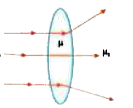Parallel rays of light entering a convex lens always converge at:
centre of curvature
the principal focus
optical centre
the focal plane
The correct Answer is:B
To solve the question "Parallel rays of light entering a convex lens always converge at:", we will follow these steps:
Step 1: Understand the properties of a convex lens
A convex lens is a transparent optical device that is thicker in the middle and thinner at the edges. It has the ability to converge (bring together) parallel rays of light that pass through it.
Hint: Remember that a convex lens is also known as a converging lens.
Step 2: Identify the behavior of parallel rays of light
When parallel rays of light enter a convex lens, they are refracted (bent) towards the optical axis. This bending occurs due to the change in speed of light as it passes through different mediums (air to glass and back to air).
Hint: Think about how light behaves when it passes through different materials.
Step 3: Determine where the rays converge
The point where these refracted rays meet after passing through the lens is known as the principal focus. This is a key characteristic of convex lenses.
Hint: The principal focus is a specific point related to the lens's optical properties.
Step 4: Conclusion
Thus, parallel rays of light entering a convex lens always converge at the principal focus.
Final Answer: The principal focus.
A convex lens is a transparent optical device that is thicker in the middle and thinner at the edges. It has the ability to converge (bring together) parallel rays of light that pass through it.
When parallel rays of light enter a convex lens, they are refracted (bent) towards the optical axis. This bending occurs due to the change in speed of light as it passes through different mediums (air to glass and back to air).
The point where these refracted rays meet after passing through the lens is known as the principal focus. This is a key characteristic of convex lenses.
Thus, parallel rays of light entering a convex lens always converge at the principal focus.
Topper's Solved these Questions
- REFLECTION OF LIGHT, MULTIPLE REFLECTION AND HUMAN EYE AND ITS CAREBOOK - AGRAWAL EXAM CART BIHARCHAPTER - REFLECTION OF LIGHT, MULTIPLE REFLECTION AND HUMAN EYE AND ITS CAREEXERCISE - JNV PREVIOUS YEAR (2007-2020) QUESTIONS
30 Videos
- PRACTICE SET 03BOOK - AGRAWAL EXAM CART BIHARCHAPTER - PRACTICE SET 03EXERCISE - SECTION - IV (GENERAL SCIENCE)
34 Videos
- SOUND (LOUDNESS, PITCH, AUDIBLE AND INAUDIBLE SOUND) AND HUMAN EARSBOOK - AGRAWAL EXAM CART BIHARCHAPTER - SOUND (LOUDNESS, PITCH, AUDIBLE AND INAUDIBLE SOUND) AND HUMAN EARSEXERCISE - IMPORTANT QUESTIONS
80 Videos
Similar Questions
Which of the two diverges a beam of parallel rays of light : convex lens or concave lens ?
View SolutionFill in the following blanks with suitable words:
a) Parallel rays of light are refracted by a convex lens to a point called the……………
b) The image in a convex lens depends upon the distance of the ……………. From the lens.
View Solution
Knowledge Check
Erect image by convex lens is always
Asame sizeBmagnifiedCdiminishedDnone of theseIf parallel beam of light falls on a convex lens. The path of the rays is shown in fig. It follows that
 Aμ1>μ>μ2Bμ1<μ<μ2Cμ1=μ<μ2Dμ1=μ>μ2
Aμ1>μ>μ2Bμ1<μ<μ2Cμ1=μ<μ2Dμ1=μ>μ2A converging beam of light is incident on a concave lens. The beam converges behind the lens at 15 cm from its centre, in the absence of the lens. Select the correct alternative
AAfter passing through the lens, beam becomes diverging, what ever may be the focal lengthBIf focal length = 10 cm, the beam diverges awayCIf focal length = 20 cm, the beam diverges awayDFocal length = 30 cm, beam converged at focal point of the lens
A concave lens always forms a virtual image.
True/False
View SolutionState whether true or false: A convex lens always produces a real image
View SolutionFill in the following blanks with suitable words :
A concave lens ___________ parallel rays of light whereas a convex lens _____________ parallel rays of light.
View SolutionWhy does a convex lens converge the light rays?
View SolutionSTATEMENT -1 : A convex lens suffers from chromatic aberration.
and
STATEMENT - 2 : All parallel rays passing through a convex lens do not come to a focus at the same point.
View Solution
